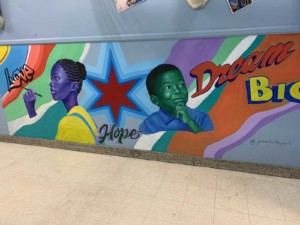Bridging The Equity Gap – Are Innovation and Technology The Equalizer or The Divider?

By: Anne Olderog
As many schools return to in-person instruction this fall, they may be walking the same halls – only to find education itself changed forever. As schools and local governments grapple with the best, CDC-recommended learning structure (in-person vs. hybrid vs. remote), instructors try new engagement methods, and learners emerge from the pandemic with more insecurities – or, in some cases, newly found self-reliance – one thing is clear. And that is that all those involved in the education ecosystem will have to navigate a new environment.
One area that is not changing (or changing for the worst) is inequity – the equity gap has been dramatically widened during the pandemic. A previous Getting Smart article established the link between schools out of session (such as during the summer break) and a widening achievement gap. Edweek spoke of the “loss of months of educational progress” in a piece on pandemic learning loss and the resulting achievement gap. The pandemic brought equity challenges to the forefront by a situation, as instructors suddenly had a window into their students’ personal lives and challenges. The broader context created a newly heightened imperative to work on addressing inequity.
How are some of the changes and trends observed during the pandemic affecting the learning gap, or the “distribution of learning”?
One aspect that increased during the pandemic is the fragmentation of education choices. As more parents were directly observing their children’s schooling (and called to contribute to that in significant ways) – some chose to join a pod, start homeschooling, or join alternative education choices. As a result, different school models including microschools exploded, and technology became prevalent, bringing with it new approaches.
As in any changing market, questions of equity are front and center in these developments. Do microschools present a low-cost option that many more can afford (or start!), creating a network of self-regulated entities supported by parent initiative and entrepreneurial fire? Are new models and tools only used by a fringe of the market, never really creating a difference in many lives? Is technology the great equalizer or is it creating a further – digital – divide?
New school models, including microschools – are just at the beginning of the innovation curve – and predicting the impact of early-stage innovations is notoriously difficult. An earlier Getting Smart piece detailed the multiple models and macro impact that microschools bring about. What is interesting is that attitudes towards new models are multi-dimensional. While the argument of reopening schools to ensure fair access was front and center, it appeared that a number of minority parents did not fully share this haste – and decided to explore other options, as the current model did not necessarily work for their children in the first place. For example, a New York Times article from the past school year quoted trust from African American families as a missing element in school reopening.
The key benefit of a microschool environment is the critical role played by the community, giving each school a much more important say in how the school is managed, and giving each child much more individual attention. For instance, SchoolHouse, a BIPOC-founded micro-schooling company that matches parents with educators to create at-home schools, raised $8.1 million last April, in its first round of funding since launching in 2020 and experiencing rapid growth late last year. Among its high-profile investors are Chelsea Clinton from Metrodora Ventures, Chris Paik and Jordan Cooper from Pace Capital, along with Bungalow and Trust Capital.
SchoolHouse contends one of its main pillars is an emphasis on diversity and inclusion that many traditional school systems do not focus on. It adds that diversity is not only reflected in the student populations, but also in the teachers the firm chooses to lead the pods, and its founding team.
In a similar vein, does technology create new barriers – in terms of broadband access, technology savviness, or pure cost – or does it remove barriers by creating a bias-free environment? Multiple studies have found that technology drives further inequalities. Yet the issue at hand is not about technology at large, but zeroing on intelligent technologies that are able to create 1:1 learning at scale, from K-12 into Higher Ed. For instance, Arizona State University was able to reduce algebra fail rates from 42% to 21% by bringing in intelligent adaptive technologies such as ALEKS (source: The Stunning Potential to Create Equity, STEM Connector).
A thought paper, The Equity Equation, published by McGraw Hill, explores another example: “The College of Health Care Professions (CHCP) saw an opportunity to face the equity gap by building college programs based on employer needs to address the skills gap of unemployed workers from disadvantaged communities like the Rio Grande Valley. CHCP’s student population is 56 percent Hispanic students, 23 percent African American students, and 17 percent Caucasian students. Eighty-eight percent of students are women, and the overwhelming majority of students qualify for Pell grants (most Pell grant money goes to students in poverty, with a total family income below $20,000).”
Three key tenets of success were gearing education towards specific, practical job opportunities identified with healthcare employers in Texas; implementing an adaptive learning system, and stackable credentials that created a series of gradual qualifications, allowing students to progress from short-term certificates all the way to bachelor’s degrees. As a result of CHCP’s efforts, the retention rate for students rose from 60 percent in 2015 to 85 percent in 2017. The graduation and job placement rate for the same timeframe rose from 65 percent to 80 percent.
The Bill & Melinda Gates Foundation launched an initiative called Every Learner Everywhere to help improve outcomes for all students. “A growing body of evidence proves that adaptive learning platforms can be a tool to create equity,” said Stacey Vanderheiden Guney, former director of Every Learner Everywhere. “We cannot support retention and student success and increasing graduation rates if we don’t carefully examine the gateway courses, which are traditionally viewed as weed-out courses. The effective use of adaptive learning systems can allow learners to come up to the same speed and be supported in unique ways in the classroom. That’s good for them and it’s good for society as a whole.” (source: The Equity Equation, McGraw Hill).
Moreover, in a study conducted at Long Beach Community College, all student groups using ALEKS, an adaptive learning program from McGraw Hill, or compressed sections of Math 110 (Beginning Algebra) outperform regular course sections. Black/African American students are twice as likely to pass an ALEKS compressed section than a regular section (using print or traditional online homework).
One element to pay attention to is the inherent bias – the algorithm perpetuates existing biases because it analyzes data created by human behavior. A Forbes article argued that technology in areas such as hiring actually perpetuates existing biases. This should be less true of adaptive software that compares every student to himself or herself rather than to a group of peers.
Ultimately, one of today’s imperative is to find responsive pedagogical approaches – to the needs of communities and individual students. In order to create responsive approaches, it is necessary to understand individual challenges at a more granular level. Microschool networks and adaptive technology are the modern counterparts to individual tutoring – enabling them to create responsive approaches at scale.
For more, see:
Anne Olderog is a Partner at Vivaldi, leading projects on growth/innovation strategy, positioning and brand architecture.
Stay in-the-know with innovations in learning by signing up for the weekly Smart Update.




Tom Hooper
I betcha technology will reduce the equity gap for sure. As you have talked about the existing biasness, I think this is the decisive factor here.
Faujtech
its really beautiful and amazing blog post! Thanks for sharing
Faujtech
Hi There!
I am an SEO Executive and am looking for a post on your website.
Our guest post is unique and informative content that will inspire your audience.
Please let me know about your guest post guidelines and you would charge for that post
Thanks & Regards
NetSuite Online Training
It's a really beautiful and amazing blog post! Thanks for sharing
Andy Globe
The blog is very well written with logical information.
mustafa
This website is very informative. I appreciate this website
Waldron institute
Thanks for sharing! As many schools return to face to face guidance this fall, they might be strolling similar corridors just to observe instruction itself. Keep sharing.
srinivas
I saw the articles about changing the generation by maybe some diseases or other but nowadays some point you said teaching. If we compare previous to now like online teach in previous physical and In this process some plus and minus too we have... Anyway good articles.